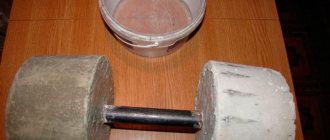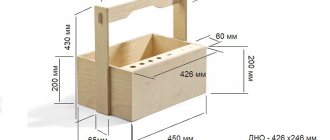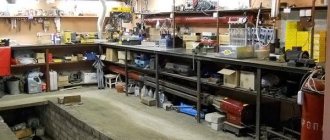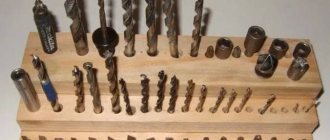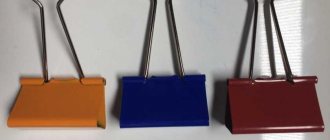No serious fishing trip is complete without a rod stand. Thanks to this thing, you can not only not constantly hold a fishing rod in your hands, but also install several fishing rods at once at the fishing spot.
Despite the fact that this design can be purchased without any problems, some anglers prefer to make it themselves. The fact is that stands are not always suitable for fishing conditions. Sometimes the bank you are looking at is too hard and of inappropriate shape, or on the bridge from which fishing will be carried out, it is impossible to attach a stand. Then you have to make a stand for fishing rods with your own hands in order to position it in the right place.
How to make a fishing rod stand with your own hands?
Any angler will agree that having a rod stand simplifies the process. You can install several rods on this device at once, so you don’t have to hold the equipment in your hands and strain. There is a wide selection of such holders on the market today, but you can make your own if you follow simple instructions. The stand can be made from wood, plastic, metal wire, with only basic tools and simple materials on hand. We offer you several options for making holders and useful recommendations.
Blitz tips
- Rod holders not only simplify the fishing process, save physical effort when waiting for a long time for the next bite, but also extend the life of the spinning rod, since the prolonged presence of a fishing rod in the aquatic environment does not have a positive effect on its characteristics.
- Popular among fishermen, the pods are produced in two types - three-legged and four-legged. The three-support version of the product is not very stable, but does an excellent job of adjusting the tilt, allowing you to set angles in a variety of ranges. This characteristic minimizes the likelihood of tangling gear located nearby during fishing. Four-support structures are very stable, however, despite this advantage, they have a small tilt range and minimal adjustment speed.
- To avoid possible interference between the spinning rods located in the line when fishing for fish (reel snags and tangling of the fishing line are often observed), they should be placed in a checkerboard pattern.
- When choosing holders in a store, you should give preference to manufacturers that have been proven over the years. Carp Zoom, Salmo, EOS are considered the best on the market. The presented manufacturers produce devices exclusively from high quality materials that can last for many years.
- The stability of the holder is greatly influenced by the weight of the device. Large-sized products are more stable than less weighty models. However, it is worth remembering that the heavy design causes a lot of inconvenience during transportation, especially if the fisherman does not have a vehicle. Based on this feature, it is worth selecting products that maintain a balance between stability and weight.
Tools and materials
Before you start making the holder, you need to carefully prepare so that everything is at hand. The set of tools and materials directly depends on what kind of device you decide to build yourself. The design elements can be made of wood, a metal hanger, or even foam plastic, so first you need to decide on the components, and only then proceed to the craft itself.
You may need smooth fittings with a diameter of no more than 0.6 mm, plastic and metal tubes of different sizes; for vertical posts you need larger pieces with a diameter of up to 50 mm and wooden pegs.
The work will not take much time or effort, moreover, this is one of the most affordable options, because to make a stand for a fishing rod you do not need anything expensive, you just need to collect available materials.
Some fishermen are able to build a homemade stand from ordinary thick wire or even a ski pole. Of course, after all the materials have been prepared, it is necessary to develop drawings in order to calculate the parameters of the future holder. To draw a diagram, it is important to decide what dimensions the structure should be.
As for tools, you cannot do without a large knife or axe; it is also important to have a jigsaw and scissors, thick thread and Moment glue. Now you can begin the process yourself. If you want to make a belt attachment for fishing from the shore, you will need to be equipped with a tarpaulin or thick fabric.
Manufacturing options
Made of plastic
This option for spinning is in great demand. To do this you will need a PVC pipe and a small piece of reinforcement. When it comes to diameter, you need to make sure that the bottom of your rod will fit inside. The essence of making a stand is to attach the fittings to the pipe using special glue; some people prefer to use tape, but this is not always reliable. It is important to put in the effort and make sure the connection is secure and strong.
The other end of the reinforcement is sharpened with a grinder, which almost every angler has, but if you don’t have a tool, it’s enough to leave the cut at an acute angle. Despite the simplicity of this device, it should be understood that fastening with tape will not be so reliable. However, a holder made from polypropylene pipes is in great demand, so you can try making one yourself in your garage.
It is worth noting that such a stand is suitable for feeder fishing, when the equipment needs to be fixed in a stationary position, and the tip of the rod will serve as a signaling device indicating bites. In addition, thanks to this device you can easily handle your fishing equipment. Feed holders for carp rods have the following advantages.
First of all, any angler can make them, they are easy to use, they are a compact device that will not take up much space during transportation.
Made of wood
From foam plastic
As surprising as it may sound, polystyrene foam can also be suitable as a material for making a shore stand. The construction method is similar to that used with plastic. The holder must be made in the shape of a disk, the thickness of which is at least 0.5 mm.
To cut such a circle, just use a simple knife; a third of the total material is cut off at the bottom to ensure stability, then all that remains is to drill a hole.
From a metal hanger
Since almost every home has a hanger, you can make a good stand out of it without spending any more effort. The inverted device must be bent in a special way. This is an alternative option to wooden pegs. It is worth noting that this type of holder is convenient and can be not only one-piece, but also two-piece. In addition, thanks to the stand, you can adjust the tilt height of the equipment.
The rear racks can be made on butt holders; here you can show all your imagination and figure out what is more convenient. A hanger rack has its own characteristics - it will reliably hold any fishing rod, be it a spinning rod, a feeder or telescopic equipment, under any conditions. Thanks to the holder, you can adjust the tilt height of the equipment and select the desired distance. However, you should choose a soft bank with soil where you can install such a stand.
It is impossible not to note such a device as a pod, which can also be made independently. First of all, you need to start working on the support legs of the holder, the length of which should reach 400 mm; if you want them to be sliding, you should make them longer. The legs are clamped to gain stability; for this, you can use an elastic band or cord to firmly tie the structure. Then a frame of the size that fits your rod is attached.
The buzz bar can be for 2 or more equipment, the design can be made larger. It is worth noting that each element must be attached to the frame at one point, this will prevent damage to the device. Once you have done this, carefully check that everything is tight and make sure that the holder is stable, after which you can test your rod-pod for a fly rod or other rod.
Overview of species
The main classification for fishing rod stands divides them all into several categories, according to functionality, purpose, and installation method. The categories can be divided according to the following parameters.
- Season. For bottom winter fishing, single versions or combs for several rods are used. The main requirement here is protection against drift in the wind. For donkeys, racks without pegs are often made, similar to racks. For summer, spring and autumn fishing, choose options with mounting in the ground.
- Fishing method. Almost all types of holders are suitable for shore installation. For trolling from a boat, special side mounts are used. They can be portable or stationary.
- Location. Vertical options hold the tip of the fishing rod, horizontal ones often have several elements - the back bar holds the butt, the front one can be equipped with alarms or adjust the position of the tip. Self-cutting equipment is available for shore fishing.
- Number of holders. Single models are available for a regular float fishing rod. Options for 2, 3 or 4 rods are in demand in feeder fishing. For carp gear, they also produce options for a larger number of holders - they are called buzz bars.
- Construction type. Telescopic models have folding sections that extend as needed. Collapsible ones are simply divided into elements with screw or other fastenings. The tripod can be folded similar to a tripod. A buzz bar with 4 support points is more like a table frame.
Butts
The most popular options for feeder fishing. Since the tackle is secured in the holder by the handle, you can remove it quickly enough when biting. You can attach such a stand directly to the shore or fix it on the frame of a chair if you have a screw clamp. The tackle does not lose sensitivity and instantly signals a bite, but it cannot always be adjusted to the desired angle of inclination.
The advantages of butt clamps include:
- wind resistance;
- compactness;
- ease of fastening;
- simplicity of design.
There are also certain disadvantages. Since most of the rod is suspended, false bite signals may occur in strong winds. In addition, when installing in the ground, you have to choose areas of the shore with dense turf soil; in the sand, the position will be unstable, and for fishing from the pier, only the option with a clamping holder is suitable.
Single racks
A simple solution designed to install only one fishing rod. It is suitable for float and feeder rods and is used in carp fishing. Single stands are easy to move and convenient to transport. Outwardly, they resemble a classic tripod or slingshot with a stock at the top; they are adjustable and static. Some models use additional screw-on sections or telescopic elements.
The obvious advantages of single racks include:
- resistance to gusts of wind;
- height-adjustable design;
- versatility in installation on different bodies of water;
- ease of arrangement when casting several tackles.
Single stands are not suitable for fishing on steep or crumbling banks. Installation on a stone or wooden base is also impossible. For hard soils, it is better to choose single holders with a screw at the end, screwed into the ground like a drill.
Wooden pegs
The simplest version of a support, familiar to every angler. The stand is easily made right on the shore; it looks like a spear with a vertical stand, pointed at the bottom, and a V-shaped branch at the top. It can be cut from a tree branch 10-20 mm thick.
Rod-under
This type of rod setting system is typical for carp fishing, but is also used in other types of fishing. The design is a self-standing support with 4 or 3 legs. Rear holders and signaling devices on the front line are installed on top of the rod pod. The most modern, technically advanced options have a full range of options for transformation:
- 360 degree rotation;
- narrowing;
- elongation;
- expansion;
- shortening;
- changing the angle of inclination.
The standard number of posts in a rod pod varies from 2 to 4. Options with a tripod mount are optimally suited for uneven shores, piers or walkways, as they ensure a stable position of all elements.
Buzz bar
A combined holder that combines the features of rod-pods and conventional stands. It consists of 2 supports, to which threaded crossbars are screwed. They are installed in pairs, equipped with holders at the rear and alarms at the front.
Recommendations
To ensure that the device is reliable and performs its function, you should familiarize yourself with several useful tips. If you use wood as the main material, you need to cover the structure with a protective varnish or paint, after drying it, this will extend the life of the structure and avoid rotting. A donkey stand can simplify fishing; it saves energy during long waits for the next bite.
If you use several fishing rods at once, it is recommended to take rod pods; this design is more stable and will also prevent the gear from getting tangled with each other. Many experts note that in order to prevent any interference between the spinning gear that is located on the buzz bar, it is necessary to place them in a checkerboard pattern, so the reels will not get caught.
To make a high-quality and durable holder, make sure that you select good materials, and it is also important to ensure that the fastenings are reliable.
It is better to make a large-sized structure, since it will be much stronger and will not only be able to transfer the load from the rod, but will ensure the stability of the equipment during sharp bites. As you can see, there are a lot of options for making a stand for fishing rods yourself, and to do this, it’s enough to have available materials and standard tools that any fisherman can find. You can experiment, make a structure from tree branches, or build something at home, where there are more opportunities to achieve quality. With such a device, any fishing will become easier and more interesting, and until the bite starts, you can do other things.
How to make a fishing rod stand with your own hands is shown in the following video.
Source
Equipment from well-known manufacturers
There is a fairly large range of products on the modern fishing equipment market. The most popular among spinning holders are the following models: Scotty, Kolibri, Avacha, Amphibalt.
Canadian Scotty stand
The manufacturer produces holders for spinning rods in a fairly large assortment.
Almost every product has a universal mount, with which this device can be fixed in any part of the boat: on the sides, transom, seats and handrails. The main advantages of holders from a Canadian manufacturer:
- using high quality materials as raw materials,
- Possibility of installation on any surface,
- adjusting the angle of the device up to 360 degrees.
All modifications of spinning stands are compatible with almost any adapters for installing Scotty holders on swimming craft.
Hummingbird model
Products under the Kolibri brand have been known on the market for a long time. The company offers high-quality stands for mounting on PVC boats. It has proven itself very well in the Russian and Ukrainian markets.
Product design:
- self-retaining device made of plywood has good moisture-resistant characteristics,
- slots for fishing rods,
- fasteners.
The plywood used for the production of fishing rod stands is pre-treated with a bakelite compound, which makes the material resistant to moisture. The fasteners are glued to the boat cylinders. Plywood is inserted into these fasteners. Using special clamping screws, the structure can be easily dismantled if necessary.
Avacha brand holders
Products from this company can also be installed on watercraft made of polyvinyl chloride.
Advantages of Avacha stands:
- a rather long glass does not allow the rod to fly out,
- the device is fixed on the side of the boat, so it does not interfere with the fisherman,
- the product has an attractive appearance, as it is made of nickel, which looks much more impressive than PVC pipes and aluminum.
Amphibalt devices
Rod stands of this brand are designed for mounting on a trolling arc using clamps with bolts. This connection is highly reliable. The product is made from 1.5 mm thick stainless steel sheet, so it is quite durable.
How to make a stand for fishing rods - a stand for fishing rods with your own hands
If you are an avid fisherman, then this homemade product will help you store and transport your fishing rods, nets and spinning rods.
In fishing stores you can find various rod storage racks designed to be mounted on a wall (for example, in a garage). We suggest using these brackets to make your own fishing rod stands that can be mounted on the wall; they can be easily removed and taken with you. The design of such a holder is quite durable, reliable and inexpensive. It is made from scraps of PVC pipes and fittings.
Such holders can be installed not only on the wall, but also, for example, on a fishing cart.
Each bracket is mounted on a frame made of PVC pipes, and the racks already mounted on the frames are installed on a separate stand. They are easy to remove and, if necessary, install on the side of the cart. If the need arises, you can make other types of stands on which the brackets will be installed.
Your design may have other dimensions and any other number of stand sections, depending on your needs. Here's what you'll need to make your own rod stand:
In some parts of the structure it is necessary to use thin-walled pipe; this will be discussed below.
Trolleys
How do you like it?
Beach carts are generally very common among our ocean-spoiled colleagues, for example, here’s a smaller option:
Another small fishing beach cart
Working example of axle assembly
Or this. As you can see, the person is engaged in this masturbation clearly not from a lack of funds.
An option for a small cart is a canoe stand.
Another boat option.
Very miniature and durable design.
This topic has become so widespread among kayakers that on the English-language Internet you can find detailed instructions with a list of parts for purchase and self-assembly. For example, here is https://palmettoka. build.html
General information and description
Buying a fishing rod stand is a good alternative to a huge stand. However, in addition to the undeniable advantages, such a fishing device also has disadvantages that appear under certain conditions.
For example, if fishing is carried out with 1-2 fishing rods, then it is advisable to use separate stands for each tackle. If you use more than two forms, you will have to buy entire structures for several rods. You can purchase such a useful accessory at any fishing store, especially since they offer a wide variety of good offers for every taste and budget. However, many fishing masters prefer making a feeder stand with their own hands, considering this a more reasonable solution . In any case, fishermen are driven by pure interest , as they are trying to find something new or collect it themselves.
But when creating a homemade design, you need to understand that its main characteristics are determined by specific fishing conditions. If the shore is hard and rocky, then it is unlikely that the stick can be stuck into the ground. A similar situation awaits the angler when fishing from a wooden bridge, where installing a stand is almost impossible.
Types of feeder holders
It is also not easy to detect in your hand a weak fish bite that occurs while it is playing with the bait. In turn, the holder designs have a fairly rigid fixation, which ensures maximum position stability in intense winds. In addition, the angler will be able to leave the fishing rod and walk along the shore, or explore other areas of the reservoir.
For fishing to be successful and comfortable, each stand must meet certain requirements:
If low posts are used, the rod tip will be placed too low, which can lead to line drift when exposed to fast currents.
Among the existing types of holders, the following should be highlighted:
To make a choice, you need to understand the features of each type in more detail.
Wooden rod stands
In most cases, fishermen use the classic version of a stand in the form of wooden stags driven into the ground. This is not surprising, because they can be made immediately after arriving at a body of water, provided that there is coastal vegetation there. The rod is cut out of wood and then installed in the ground. Of course, not all fishermen agree to kill nearby bushes and trees, disturbing the local ecosystem, and a sharp peg can damage expensive gear when performing aggressive hooking. If we talk about the advantages of this option, they are presented as follows:
However, besides the advantages, wooden inventions also have disadvantages..
It is no secret that not all bodies of water have trees or bushes from which a stand can be made. And in their absence, fishing will be uncomfortable and problematic. In addition, one cannot ignore the fact that the number of fishermen is constantly growing, so cutting vegetation causes serious damage to the ecosystem. However, many of them use last year’s flyers, which lie in large numbers on the shore.
Rod racks
Another popular type is the design, which is made on the basis of thick racks.
They are fixed directly on the shore, after which they are connected by a double crossbar. Thus, the angler can use up to two fishing rods at the same time. If we are talking about feeder fishing, then it is advisable to use a single version made of stainless steel or aluminum. The fact is that such designs are very convenient and suitable for fishing at different points. To give the mechanism increased stability, it is better to fix the racks in pairs : one to the top of the fishing rod, and the second to its base. If the soil is quite dense, then screw-in products can be used.
As for ordinary stands, they are simply driven into the ground, but only with a rubber mallet, because other methods can scare the fish or even damage the fishing equipment. If we talk about the advantages of racks, they look like this:
The only disadvantage is the inability to use it on a hard surface. That is, if fishing is carried out on a rocky shore or hard surface, then such stands are useless.
Butt type stands
Modern fishermen are rapidly changing their preferences , abandoning classic products in favor of something more modernized. And when choosing stands, many of them give preference to butt holders, which are easy to manufacture and affordable. Such designs are capable of holding the feeder form by the handle, so they are especially effective when it is necessary to install feeder forms in one position. The tip is used as a bite indicator.
The advantages of butt holders are:
The only disadvantages that stand out are the limitations in terms of installation due to the nature of the soil, as well as the difficulty of detecting a bite in strong gusts of wind.
Modern rod-pod
If for some reason the fishing takes place on a hard bank, for example, when it is strewn with stones, or you are placed on a wooden platform, then it is advisable to use a completely different type of holder, called a rod-pod.
At its core, a rod-pod is a multifunctional stand that can be used for feeder, spinning, and float fishing, regardless of the type of shore surface.
There is no need to drive the posts into the ground, because the design is a connection of the front and rear posts by means of crossbars with inserts for three or four fishing rods.
In addition to the designs themselves, anglers recommend purchasing a bite indicator, or making one yourself, as well as a folding chair.
When choosing a modern tripod , you need to consider several important recommendations:
The advantages of such modern products include:
As for the disadvantages, they are practically absent, with the exception of the increased likelihood of fishing lines sticking due to their close proximity to each other.
Features of use
When going winter fishing, a stand designed for this time of year will be a great help.
One of the proven types of devices that experienced fishermen advise using in the cold season is the “balalaika”. Making such a device does not require any specific knowledge and skills. Using an ordinary polyvinyl chloride lid from a glass jar as a basis, we carefully cut through the stand for the fishing rod. In the resulting workpiece, holes should be drilled for the fishing line and for the six.
Such a stand has more than once rescued fishermen on frosty days and nights, helping to keep the gear stationary even in strong winter winds. The use of metal holders is not recommended during the winter months.
When going fishing on a boat, you also cannot do without a stand that provides comfort and convenience. In this case, fishing rod stands that are mounted on the side of the boat are ideal. A similar product can be purchased at any specialized store.
The device holder is made of moisture-resistant plywood with slots for gear. The devices are removable. As soon as the fishing hunt comes to an end, you can easily dismantle the holder. The device is secured with clamping screws, allowing you to install and remove the holder in a matter of seconds.


